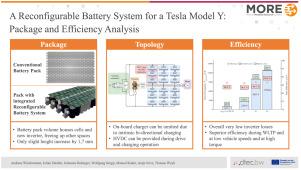特斯拉Y型可重构电池系统:封装与效率分析
IF 17
1区 工程技术
Q1 ENERGY & FUELS
引用次数: 0
摘要
本研究探讨了一种基于多电平逆变器的模块化可重构电池系统与现有电动汽车的集成。目的是评估这种系统如何取代传统的牵引逆变器、电池管理系统和车载充电器。为此,对电力电子器件、控制逻辑和驱动电子器件的不同拓扑级别和可能的集成形式进行了分类。特斯拉Y型的牵引电池进行了重新设计,保留了其结构特性和4680电池格式。封装分析表明,多电平系统占用的体积与传统电池组相当,而以前为专用电力电子设备保留的体积变得可用。效率仿真结果表明,多电平逆变器可以提高整车效率,特别是在低速和高转矩要求的情况下。因此,WLTP能耗从14.9千瓦时/100公里降低到14.5千瓦时/100公里。然而,由于更高的电池电流,电池效率在更高的速度下会降低。此外,该系统还可以在全系统功率下进行双向充电,包括向外部负载或电网供电,以及更集成的车辆架构。本文章由计算机程序翻译,如有差异,请以英文原文为准。

A reconfigurable battery system for a Tesla Model Y: Package and efficiency analysis
This study investigates the integration of a modular multilevel inverter-based reconfigurable battery system into an existing electric vehicle. The aim is to evaluate how such systems can replace conventional traction inverters, battery management systems, and on-board chargers. To this end, a classification of the different topology levels and possible forms of integration of power electronics, control logic, and driver electronics is performed. A Tesla Model Y’s traction battery is redesigned, retaining its structural properties and the 4680 cell format. A package analysis shows that the multilevel system occupies a volume comparable to the conventional battery pack, while the volume previously reserved for dedicated power electronics becomes available. Efficiency simulations demonstrate that the multilevel inverter can increase the overall vehicle efficiency, especially in situations with low driving speeds and high torque requirements. As a result, WLTP energy consumption is reduced from 14.9 kWh/100km to 14.5 kWh/100km. However, the battery efficiency is reduced at higher speeds due to higher cell currents. In addition, the system enables bidirectional charging at full system power, including supply to external loads or the grid, and a more integrated vehicle architecture.
求助全文
通过发布文献求助,成功后即可免费获取论文全文。
去求助
来源期刊

Etransportation
Engineering-Automotive Engineering
CiteScore
19.80
自引率
12.60%
发文量
57
审稿时长
39 days
期刊介绍:
eTransportation is a scholarly journal that aims to advance knowledge in the field of electric transportation. It focuses on all modes of transportation that utilize electricity as their primary source of energy, including electric vehicles, trains, ships, and aircraft. The journal covers all stages of research, development, and testing of new technologies, systems, and devices related to electrical transportation.
The journal welcomes the use of simulation and analysis tools at the system, transport, or device level. Its primary emphasis is on the study of the electrical and electronic aspects of transportation systems. However, it also considers research on mechanical parts or subsystems of vehicles if there is a clear interaction with electrical or electronic equipment.
Please note that this journal excludes other aspects such as sociological, political, regulatory, or environmental factors from its scope.
 求助内容:
求助内容: 应助结果提醒方式:
应助结果提醒方式:


